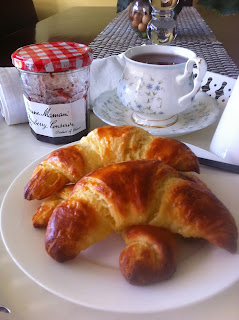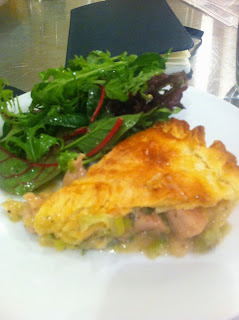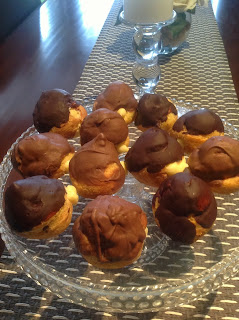 |
| Fruit Tarts |
The ability to make your own pastry is so liberating. It opens up so many options, with each different type of pastry being able to be made into any number of recipes.
Whilst anyone can mix a list of ingredients together, it is the pastry skills and know how that are not included in the recipe that are important to master. These skills can be applied to the making of all types of pastry.
Tip # 1
Always use unsalted butter. By beginning with unsalted butter, you are able to control the taste of your pastry. Too salty and its ruined! Need some salt? Then add some...
Tip # 2
Ensure any pastry that has butter incorporated into it has been refrigerated prior to rolling it out. If the butter in a pastry is too warm, it looses its form and falls apart.
 |
| Resting in fridge |
This makes the task of rolling the pastry out to a desired shape impossible. If the butter is cold, the pastry will not stick to the bench when being rolled.
Tip # 3
When rolling out pastry, do not roll the pin over the edge of the pastry. Pinched ends are thinner than the rest of the pastry and cook faster than the rest. This may result in blackened ends instead of a golden brown or may cause you to pull your tart out before the rest of the pastry is cooked through.
Tip # 4
Rather than moving your pin to roll out your pastry, move your pastry. Rotating your pastry 90 degrees enables better utilisation of your biceps. Always roll your pastry away from you. This ensures even pressure is used and will not result in unevenly rolled pastry.
Tip # 5
If you need to roll out pastry to a particular shape, begin with your pastry in that shape. After kneading your dough, use your hands to mould pastry into desired shape prior to rolling it out.
Tip # 6
Weigh your wet ingredients to ensure accuracy. There's nothing worse than a bowl of clay due to miscalculation. 1 Cup = 250ml = 250g; 1 Tbsp = 20ml = 20g.
Tools of the Trade
Recipes
Sweet Shortcrust Pastry
200g butter
80g icing sugar
2 egg yolks
300g plain flour
iced water
Preheat oven to 200 degrees Celcius. Grease and flour tart tin.
Using mixer, cream butter and icing sugar until pale and smooth. Add yolks, one at a time, continue to mix until smooth.
Add sifted flour and enough iced water to just bring together with fingertips.
Tip onto bench, bring together and wrap in plastic wrap to rest for 1 hour. Roll out to 5mm. Line tart mould and freeze.
Blind bake for 15 minutes on 200 degrees Celcius. Remove baking beads and reduce temperature to 160 degrees Celcius and cook for 10 minutes.
Application - Chocolate Tart
350 ml thickened cream
150ml milk
3 eggs, lightly beaten
500g 70% chocolate
Place cream and milk in saucepan and boil. Pour onto lightly beaten eggs and whisk to incorporate.
Pour onto chocolate and using spatula, work the cream into the chocolate until melted.
Pour into tart shell. Tap to remove air bubbles and place into a preheated oven. Turn off oven immediately. Leave in oven for 30 minutes.
Refrigerate after it has cooled for a more solid finish or else, leave in a warm place for a gooey version.
 |
| Chocolate Tart |
Shortcrust Pastry
260g plain flour
1/4 tsp salt
130g cold butter
60ml chilled water
1 egg yolk
Place flour and salt in bowl. Cut butter into 1cm cubes. Add to flour and use fingertips to combine until it resembles fine breadcrumbs.
Lightly whisk water and egg yolk together and add to flour and butter mix. Using a rounded edge knife, mix to form a crumbly dough.
Tip onto bench and knead gently and briefly to form a smooth dough.
Roll out on lightly floured surface and line tin.
Refrigerate for 30 minutes to allow to rest, then cook as required.
 |
| Chicken, Leek and Bacon Pie |
Application - Chicken, Leek and Bacon Pie
60g butter
800g chicken thighs, chopped into 2cm cubes
1 sprig rosemary
250g leek, finely sliced
150g bacon rashes, cut into lardons
salt and pepper
2 Tbsp plain flour
60ml dry white wine
125ml chicken stock
125ml milk
1 large egg, whisked for brushing pastry
Melt half the quantity of butter in a large frying pan, add rosemary and sear chicken, seasoned with salt and pepper over high heat until coloured. Remove from pan.
Fry bacon in same pan with remainder of butter for 3 to 4 minutes, until it becomes crisp.
Wash leek under running water. Drain and add to bacon in pan. Cook for 5 minutes until soft.
Add flour to pan and turn heat to medium. Stir to form a roux paste and fry for a minute. Turn heat back to high and pour in wine. Stir, allowing to sizzle for 30 seconds and then add stock and milk. Add reserved chicken and rosemary.
Season and bring to a boil, stirring well to remove lumps in sauce. Chill filling until cold.
Preheat oven to 200 degrees Celcius.
Brush rim of pastry case. Fill raw pastry case with chilled chicken mixture.
Roll out "lid" and place on top of pie. Pierce lid 3 or 4 times with a sharp knife to allow steam to escape whilst cooking. Bake for 30 to 40 minutes until golden.
Sweet Shortcrust Pastry
250g plain flour
pinch of baking powder
pinch of salt
80g caster sugar
160g cold butter, cut into cubes
1 egg
1/2 tsp vanilla extract
Sieve flour and baking powder together. Add sugar and mix. Rub in butter until it resembles fine breadcrumbs.
Lightly beat egg and stir into flour mixture with extract. Do not overmix at this stage. Tip onto bench before dough has formed.
Lightly and briefly knead pastry, until smooth. Line tin and and refrigerate.
 |
| Rasberry Almond Tarts prior to baking |
Application - Rasberry Almond Tarts
100g butter at room temperature
100g caster sugar
2 eggs
30g plain flour
1/2 tsp vanilla paste
100g almond meal
125g frozen rasberries
Preheat oven to 180 degrees Celcius.
Place butter and sugar into mixer and beat for a few minutes, until light and fluffy.
Add eggs, one at a time, adding flour and vanilla paste with second egg. Beat for a few minutes, until smooth. Add almond meal and mix briefly to combine.
Fill tart shells to 3/4 capacity and spread using back of a spoon. Place rasberries into mixture.
Bake for 25-30 minutes, until golden and slightly puffed. Cool on wire rack and remove from tins.
Puff Pastry
640g plain flour, sifted
60g butter, melted
320ml water
2 tsp salt
dash of white vinegar
500g butter, softened
Place flour into a bowl. Make a well and add melted butter, sugar, salt and vinegar.
Mix together then knead on bench for 5 minutes until it becomes smooth and elastic. Wrap in plastic and refrigerate overnight.
Using a rolling pin, roll dough outwards to a 1/2 cm thickness. Turn the dough three times, each time repeating this so that it forms a large square with four rounded petals around a slightly thicker centre.
 |
| Adding the butter to the 'flower' |
Shape the butter so that it sits in the centre. Fold the four petals over the centre to cover the butter, pinching the edges to hold the butter in.
On a lightly floured surface, turn the dough over and roll it out until it is three times longer than it is wider.
Fold the dough into thirds. Give the square a quarter turn so the folded seams are on the sides. Repeat the sequence of rolling out and turning . Wrap in plastic and refrigerate for 45 minutes.
Repeat the turning and rolling process another two times and rest again in the refrigerator for 45 minutes. Repeat once more, making it a total of 6 times. Rest the dough for 3 hours before using.
Application - Palmiers
400g puff pastry
egg wash (1 egg yolk, 1 egg and 50ml milk combined)
icing sugar, sifted
Roll out pastry onto floured bench until it is 2mm thick, forming a rectangle three times longer than it is wider. Brush with egg wash and sprinkle generously with icing sugar.
Fold the edges of the pastry to meet in the middle, forming a square with a vertical seam down the middle. Brush again with egg wash and sprinkle with sugar. Fold the pastry in half along the vertical seam. Refrigerate for 30 minutes.
Preheat oven to 200 degrees Celcius and line a baking tray with baking paper.
While still cold, cut the pastry into 1cm thick slices. Place the slices cut side up and fold the outer ends around to meet in the middle.
Place them on a tray and cover them with a sheet of baking paper. Place another tray on top to prevent them from rising whilst baking.
Cook for 10 minutes. Gently take off the top tray and baking paper. Turn each biscuit over and cook, uncovered for a further 3 minutes until they are caramelised and golden in colour.
There are so many ways in which to apply these recipes..I've included a few photos of a few of the things I've made in recent days. It's truly been a tasty learning curve!
 |
| Tarte Tartin |
 |
| Lemon Meringue Tart |
 |
| Tarte au Citron |
 |
| Quiche |
 |
| Choc Rasberry Tart |
I was recently asked the question "why make it when you can buy it?" My response to this is that when you make it, you know you can! You'll never know if you never try.... Happy Baking!













































